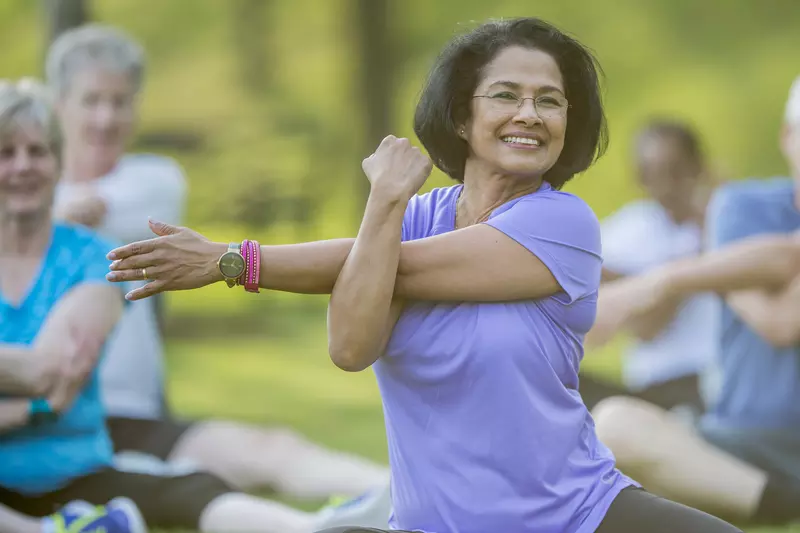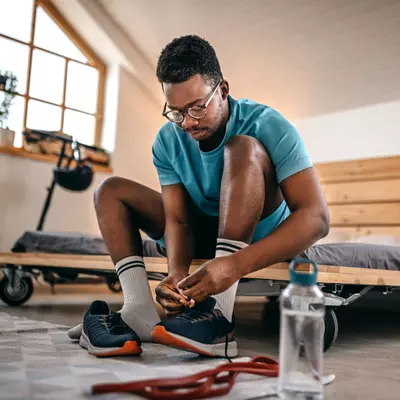- AdventHealth

Getting older means you’re putting more wear and tear on your joints, but it doesn’t mean you must grit your teeth and accept the pain. Even though it can feel like an uphill battle, achy knees, shoulders and hips are not inevitable. Instead, think of this pain as a reminder to invest more effort into taking care of your joints.
For tips on how to get the most out of your natural joints — and delay or avoid replacement surgery — we talked to AdventHealth Orthopedic Surgeon Dr. Richard Konsens.
As a world-class long jumper — he finished in 10th place in his age group in the World Masters Athletics Championship in 2015 — Dr. Konsens knows a thing or two about caring for your joints. He suggests three ways to preserve your body so you can keep doing the activities that you depend on for a healthy and fulfilling life.
1. Start a Stretching Routine
Many people deal with joint soreness that’s caused by muscle stiffness, especially after sitting for long periods.
“Stretching for a few minutes a day can go a long way, and a habit of daily stretching is something most of us can do,” Dr. Konsens says. He recommends stretching in the morning or at night before bed.
As for exercise, the advice around stretching has changed in recent years, Dr. Konsens says. Instead of performing “static” stretches before working out, where you lean into a stretch and hold it, try a “dynamic” stretch. This is the sort of stretching where you move your body — swinging your legs, rocking back and forth, that type of thing — as you stretch.
“Now we know dynamic stretching brings more blood to the muscles and more closely simulates the activity you’re about to do,” Dr. Konsens says.
Stretching isn’t just for athletes.
For many older adults, sitting still for a long period of time, especially in the car or movie theater, can cause pain. But stretching for a few minutes beforehand can prevent it.
“It’s reasonable to spend a few minutes stretching the hips and knees to prevent some initial discomfort,” he says.
Plenty of stretching ideas are available online, Dr. Konsens says. One tip to stretch your heel and hamstring is to stand up straight in front of a wall, lean forward with your legs and back straight and put your hands against the wall.
2. Try Icing — And Keep Trying It
Though many of us tend to put heat on an injured limb or joint, the opposite is a much better bet.
“You never see a professional soccer or football player put heat on an injury, and it’s generally not recommended,” Dr. Konsens says.
Instead, try icing a joint that’s in pain for about 10 or 15 minutes a few times a day. Many people make the mistake of not icing for long enough.
“If you sprain an ankle or have a minor injury, you should ice it a few times a day for a few weeks,” he says.
And, as with stretching, icing can also prevent pain before it occurs. Dr. Konsens draws a helpful analogy with brushing your teeth.
“You don’t wait until your teeth hurt to brush them and you shouldn’t wait until your joints hurt before you ice them,” he says.
Icing isn’t only good medicine for treating injuries; it can also help with long-term pain.
“There are plenty of people who have bad knees and I suggest that they ice their knees as a regular part of their routine.”
3. Know the Red Flags and Seek Medical Help
These home remedies shouldn’t be a replacement for medical help when it’s needed. Talk to your doctor about your joint pain if you experience any of the following:
- Worsening pain
- Fever
- Redness
- Swelling that doesn’t go down over time
Similarly, if you hurt a joint there is a time for icing and a time for urgent care. If any of the following happens to you, seek immediate help:
- Severe swelling
- Visible deformity
- Joint or bone is unable to bear weight
On the other hand, if you see gradual improvement to injury or joint pain with over-the-counter medications, icing and stretching, a doctor’s appointment is usually not necessary.
Finally, consider a concept called “relative rest” for joint pain, Dr. Konsens says. That doesn’t mean to stay in bed, but to avoid the few activities that bother your joint.
“If running up a hill bothers you and running on flat land doesn’t, then don’t run uphill,” he says.
Dr. Konsens continues to look after his own knees, too, considering he’ll still be racing after his upcoming 60th birthday — and in a new age bracket.
While not everyone needs to care for their joints to participate in global sporting contests, everyone has their own reasons to stay mobile. Perhaps you want to dance at a family member’s wedding, or just continue to take evening strolls with your spouse.
For more information about how AdventHealth l can help you stay free of joint pain and keep you doing the things you love, make an appointment with a specialist or call Call833-205-6607.



